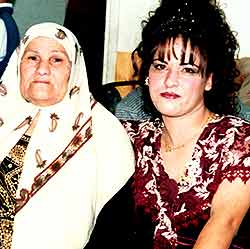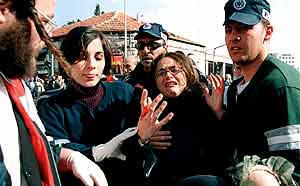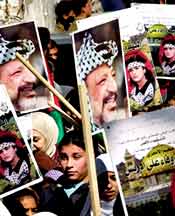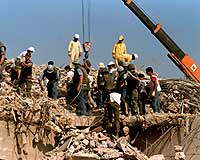
“Sacred” Explosions
|
By Gordon Thomas
From early 2002, the world has witnessed a new dimension in Middle Eastern terror, each incident alarming in its own right.
Since the first female bomber blew herself up on January 27 of that year, five others have followed. The tally to date: at least 18 killed, in addition to the bombers themselves, and approximately 240 injured.
At least eight other women were reportedly sent on similar missions, but were apprehended or had a change of heart. In the most recent case, an arrest was made in January 2003.
Based on interviews with the first bomber’s mother and unique sources within the world of intelligence, the author examines how terrorists are created and funded — vital information to understand in efforts to bring the violence to a halt and restore constructive communication.
|
She hoped as many Jews as possible would suffer a similar fate from her actions. She was about to become a shaheed, a martyr to her militant cause — a suicide bomber to the rest of the world. There had been many bombers before her, but Wafa’a was assured of her place in the pantheon of martyrdom: the first woman suicide bomber to launch herself against unsuspecting Israelis.
Her mother, Wasfiya, would later say you had to watch her only daughter in motion to really appreciate her. Her neighbors in the impoverished Palestinian refugee camp in Ramallah said Wafa’a always seemed to be in motion as she strolled through streets which have no names, smiling at the men, but rarely stopping.
Wasfiya’s home has a living room and two bedrooms. The floor is bare earth covered with cheap rugs bought in one of the nearby souks. There is a naked electric light and an oil lamp in case the Israelis cut the electricity supply. It happens.
The furniture is dominated by a couch made of camel skin. But Wasfiya prefers to sit on the floor, a throwback to her days as a child when the family lived in a tent.
On that Sunday morning Wafa’a was close to her 32nd birthday. Her proudest gift was a framed photo of Yasser Arafat, personally given to her by the chairman of the PLO. She had been a member of his Fatah organization since.
Descending into a World of Ruthless Violence
| With a number of suicide bombers, it has been documented that psychotropic drugs were used as an integral part of the conditioning process. |
At 18, she married a distant cousin who was a blacksmith. Ten years later, his mother forced the couple to divorce because Wafa’a had been unable to produce a child.
As simply as that, the chain of events, link by link, had been forged to finally bring Wafa’a to this Sunday morning.
First she joined the Red Crescent Society after the divorce, working as a paramedic for Islam’s equivalent of the Red Cross.
After the October 2000 Intifada began, “She was in the thick of the fighting. She would help the injured and often carry the badly wounded and dying children,” her mother would later say with pride. “At the end of a long day in the front line, my daughter would cry in my arms as she recalled the terrible things she witnessed.”
Socially, Wafa’a’s circle of friends started to change. In the back street cafe she sipped coffee with members of Hamas. Founded in 1987 during the first Intifada, in which she participated, Hamas had plans for sweeping changes in a new state.
She also began to mix with Hezbollah, an equally extreme group. Its members filled her mind with a brand of radicalism that embraced political terrorism.
Israel’s Shin Beth — its internal security force — later established that she became involved with Palestinian Islamic Jihad. It was another step into the world of ruthless militancy that now permeated her life.
During the month of Ramadan, 2001, she met a recruiter for the Al-Aqsa Martyrs Brigades. It provides the largest number of suicide bombers. The Martyrs — as they are known — are the most violent of all Israel’s internal enemies.
Now, on this Sunday, just weeks after being accepted by The Martyrs, she was finally ready to die for them.
“The Tailor of Death”
On Saturday, the night before, while the streets of Ramallah were filled with young disco-goers, an elderly woman delivered a packet to the house where Wafa’a lived with her widowed mother.
The packet contained a new bra and panties, along with a customized body suit. It was designed to conceal up to six pounds of high-explosives and specially sharpened nails and razor fragments.
The suit was designed to fit under Wafa’a’s street clothes. It had several pockets deep enough to take sticks of explosives. They would be distributed around her upper torso. Other pockets around her waist were for the nail and razor fragments.
Wafa’a never met the person who made the suit. He was said to come from the West Bank refugee camp of Jenin, reported to be the “capital of suicide attackers” and decimated in early 2002 by Israeli forces.
To Shin Beth the man was known as “The Tailor of Death.” The intelligence service eventually established he was a highly skilled craftsman who uses a treble stitch to sew the suit. It is made from a cloth sold in Arab shops for making undershirts. The sewing cotton came from a similar source. Shin Beth decided the tailor probably used an old-fashioned, hand-operated Singer sewing machine.
Again, but only later, would it emerge from the Israeli intelligence community that Wafa’a’s suit, like all those worn by male suicide bombers, had been designed so that the distribution of explosives was carefully balanced and that the explosive effect would cover the widest possible area.
Last Moments
Wafa’a’s mother later recalled her daughter had laid out her body suit and clean underwear on her bed early on that Sunday morning. Then she had chosen her finest hipster jeans and a loose-fitting blouse to conceal her body suit.
By then she had been joined by her “spiritual adviser” — a male member of The Martyrs. Together they had set off on the long hike over the hills and along dry river beds toward Jerusalem.
The only clue we have as to what Wafa’a was like in those last moments on earth comes from her mother.
Sitting on the floor of her living room in Ramallah, cradling the signed photograph of a smiling Yasser Arafat, Wasfiya Ali Idris spoke of the last time she saw her daughter alive: “She was very calm. She told me I was not to worry.”
Shortly after noon on that Sunday, Wafa’a Ali Idris blew herself up in a crowded Jerusalem street. She killed an 81-year-old man and injured more than 100 other men, women and children. The explosives blew off her head and one arm, and left a gaping hole in her abdomen. An hour later, the radios in Ramallah proclaimed her to be “a true heroine of our people.”
Suicide Forbidden
On that Sunday when she killed herself, the Jihad Committee in Ramallah issued her photograph to the media. That evening her mother was a guest of honor at a celebration in the street where Wafa’a lived.
Hundreds of people came to celebrate her martyrdom; the street party resembled something close to a wedding. Soft drinks and cakes were served and her mother ululated in joy over the honor Allah had bestowed upon her family.
Since Wafa’a died, five more young women in the region have experienced similar fates. Between the six, they killed or injured more than 250 people.
Their actions are described as “sacred explosions.” Yet the act of suicide is forbidden in Islam. Still, the spin doctors of The Martyrs are well versed in the black art of propaganda.
How had Wafa’a been manipulated in the name of religious extremism?
The answer lies in the dark and dangerous world of manipulative psychological techniques which ultimately led to the attack on the World Trade Center, the Pentagon and all the other suicide bomber attacks across the Middle East, in Pakistan and in the Philippines.
Destroying Any Move Toward Peace
|
Al-Abub, a master at his craft of controlling and influencing behavior, wields an arsenal that includes psychotropic drugs. It was he who administered uppers to the Beirut drivers before their deadly missions. Al-Abub today works in the Iranian prison system — a terrifying laboratory for a mad doctor dealing in torture and mass death.
In Israel, the first suicide bombing took place in April 1993. Others soon followed, killing hundreds and wounding thousands. Men, women and children died on buses, in shopping malls and cafes and on the way to school. Each death had one common purpose: to wreck any move to bring peace to the region.
Each potential bomber is recommended to the Jihad Committee. This is a little-known group within The Martyrs. Their exact number is unknown. To avoid Israel’s electronic eavesdropping apparatus — a helicopter hovering high over the West Bank can pick up a whispered conversation in a house — the Committee members communicate all important decisions through handwritten notes.
Those notes include a decision on a likely candidate to be a suicide bomber. Long before the person is approached, careful checks are made into the family background. The fear the Israelis will plant a potential bomber so as to get close to the Jihad Committee is a constant threat. There have been at least two such betrayals.
Pre-Conditions and Preparations
There are pre-conditions. No bomber must be the sole wage-earner in the family. If two brothers or sisters volunteer, only one will be chosen. A favorable decision made, the candidate is invited to meet the Jihad Committee. These meetings are often held in public places, again to reduce the risk of electronic surveillance.
The first meeting focuses on a candidate’s religious knowledge. Only later are they closely questioned about their political commitments. If the Committee is satisfied, a candidate is told he will be placed on a list of suicide bombers. No one knows its size. The Israelis believe it numbers hundreds.
The preparations for martyrdom are conducted inside a mosque, usually in a back room far from prying eyes. The imam has an “assistant” — a member of the Jihad Committee — who spends many hours each day with a candidate in the run-up to his or her death.
During the preparation stage, each bomber is repeatedly assured that on the Day of Judgment he or she will be allowed to enter Paradise, interspersed with checks to ensure that the would-be bomber’s belief in martyrdom has never wavered. Mentors repeat time and again: “You die to achieve Allah’s satisfaction. You have been chosen by Allah because he has seen in you all that is good.”
|
The first sign that tells a bomber he is about to go to his death comes when he is joined by two “advisers” who replace the “assistant.” Older men steeped in extremism, their task is to ensure a bomber does not waver in his or her readiness to die.
As the time grows closer to his mission, the bomber is moved to a specially prepared room. The indoctrination becomes more focused. The bomber is told Paradise is very close. When the time comes, all he or she must do is press the detonator button to enter the promised world.
For hours the advisers and the human bomb continue to pray together and partake in long fasts. In between, the practical side of departure to Paradise is taken care of. All of the bomber’s earthly debts are settled by the Jihad Committee. Family members are told they will become honored members of their community.
There are constant checks to ensure the bombers show no signs of fear. Reassured, the advisers then confer on each the title of “al shaheed al hayy,” the living martyr.
In the final stages, the bomber places a copy of the Koran inside his or her clothes. Over it goes the body suit. A wire to the detonator button is taped to the palm of the right hand.
The advisers escort the bomber close to the target area. They bid farewell with the promise given to all human bombers. “Allah is with you. Allah will give you success so that he can receive you in Paradise.”
Later, as the bomber presses the button, he cries out, “Allah akbar.” Allah is great. All praise to Allah.
Almost certainly these were the last earthly words Wafa’a Ali Idris spoke.
Psychological Indoctrination
Dr. Ariel Merari, a ranking expert on the techniques of suicide bombers at Tel Aviv University, likens the process to psychological indoctrination or brainwashing. Indeed, the techniques are similar, and there are many reports of drugs being the suspected catalyst. There is constant repetition that Allah approves of this way to deal with the hated enemy.
“It is a form of conditioning, rather similar to what the Chinese and Russians developed during the Korean War,” he said.
As part of preparing a candidate for death, contacts with the family are reduced to a minimum. This is to reduce any hesitation over severing earthly ties. He or she is constantly reminded of the new life ahead.
In a number of cases, it has been documented that psychotropic drugs were used as an integral part of the conditioning process.
Only when a candidate is on the eve of martyrdom is he or she usually allowed final time with his or her family. In part this is to test whether or not they will weaken in their resolve.
Wafa’a, for example, spent her last two days with her mother. Only when she had taken delivery of her underclothes and body suit did she let her mother know what was going to happen.
“We prayed together. For Palestine. For my daughter’s safe journey to a better world,” Wasfiya Ali Idris would recall.
She is herself a woman who sees life through the prism of extremism. Her reading is confined to the Koran; her hero is Yasser Arafat. Her dream is that her daughter has gone to her death to help create a Palestinian homeland.
Funding from Iran
 Gordon Thomas is author of 46 books, with total sales exceeding 45 million copies. Seven have been made into major motion pictures, including Voyage of the Damned, which received five Academy Award nominations. His bestseller Gideon’s Spies: Mossad’s Secret Warriors (St. Martin’s Press) has been published in 55 countries. His most recent book is The Assassination of Robert Maxwell: Israel’s Super Spy (Carroll & Graf, New York). He is co-editor of www.Globe-Intel.net. |
The money is said to come from Iran, laundered through the Central Bank of Syria in Damascus and the Central Bank of Greece in Athens. From there it is electronically transferred to an account in Cairo. Then it is couriered to Gaza City for distribution.
Mossad, the Israeli intelligence organization, believes electronic transfer links also exist from Tehran to Cairo and to Yemen. It has devoted considerable time to try and trace the final destination of the money in the hope it could lead them to the men who prepare the bombers.
For the suicide bomber there is only glory. In the world they inhabited there is little enough of that.
After Wafa’a died, a leaflet was circulated with her photo throughout the West Bank. It read: “We do not have tanks or rockets. But we have something superior — our Islamic human bombs. In place of a nuclear arsenal we are proud of our arsenal of believers.”
The one certainty is that in the Palestine region where two-thirds live below the poverty line, desperation reigns among families to the degree that detonating oneself — and others — can appear to be a solution. And young men and women will continue to be exploited.





